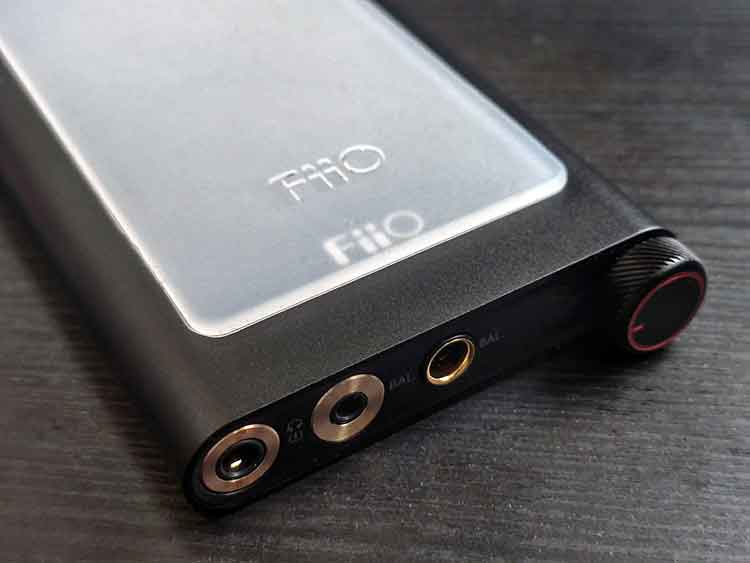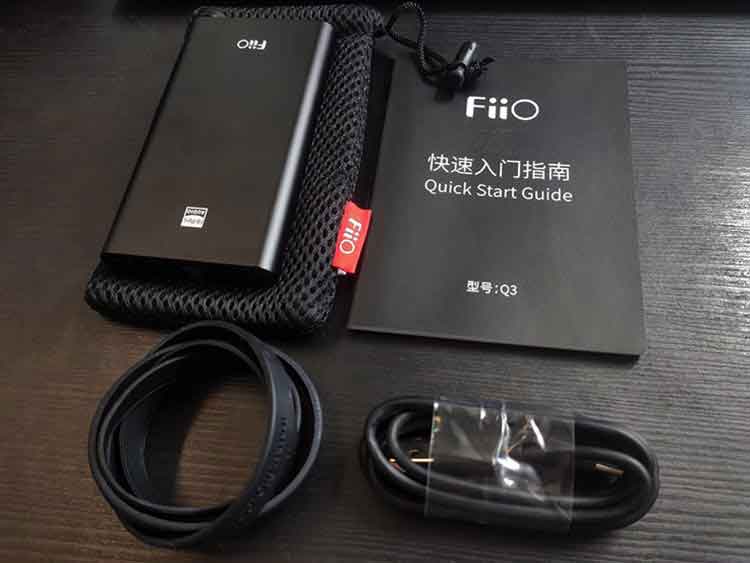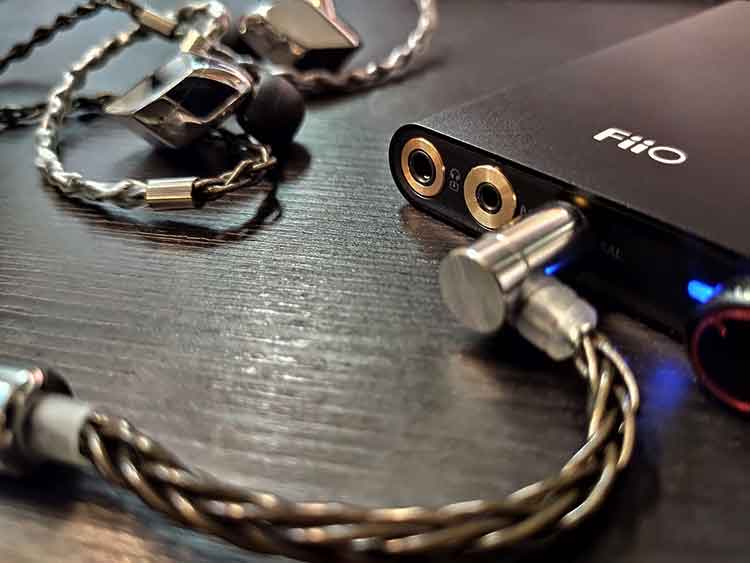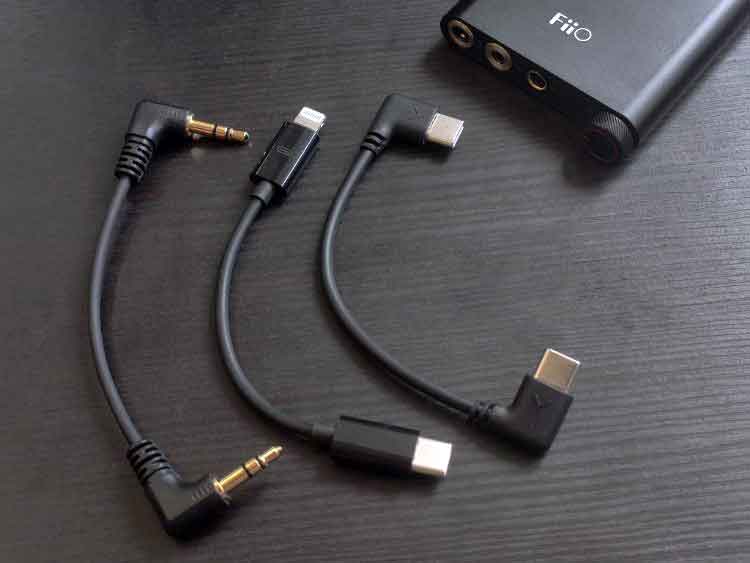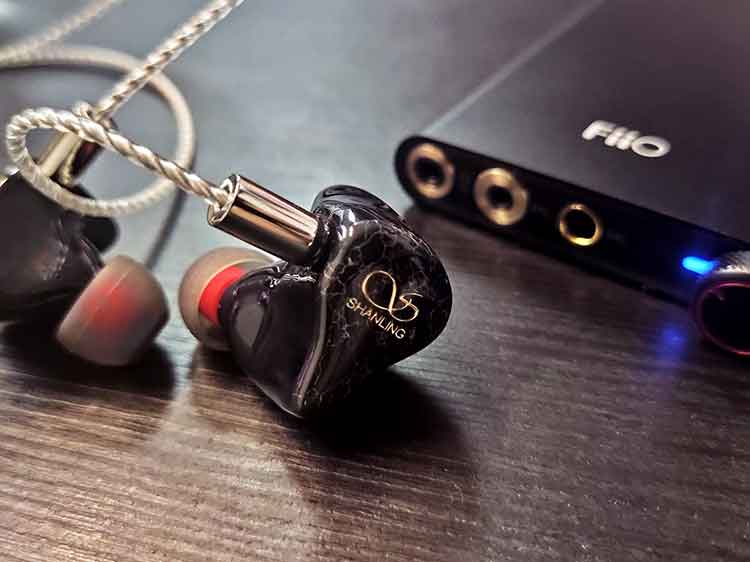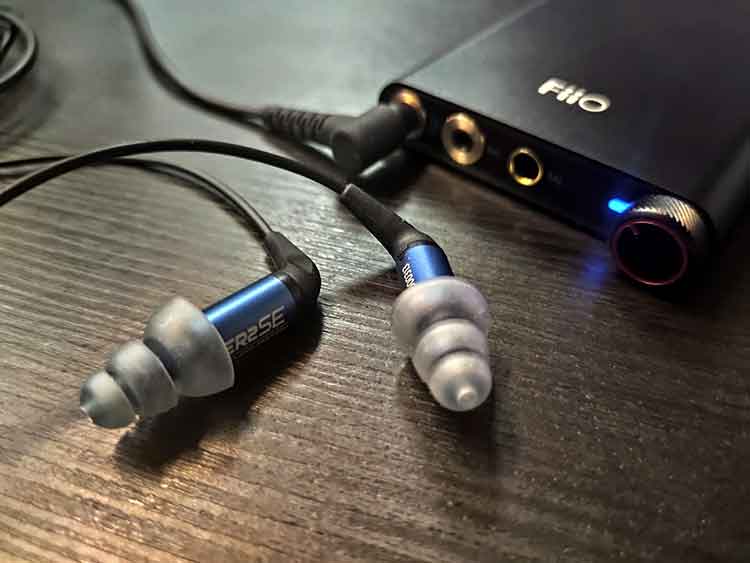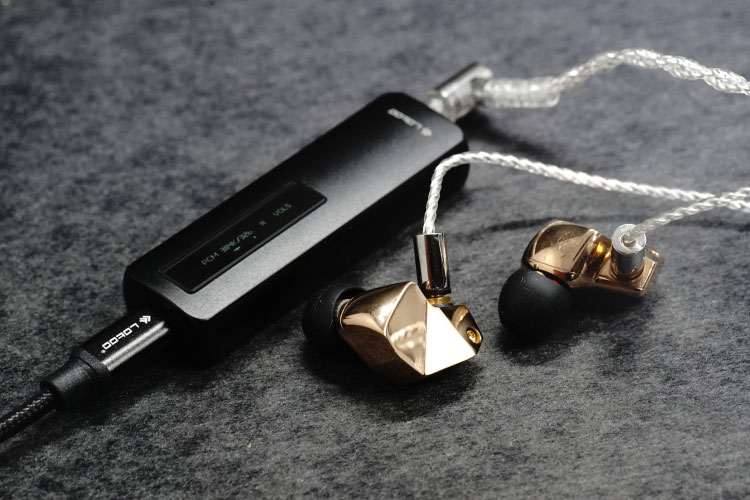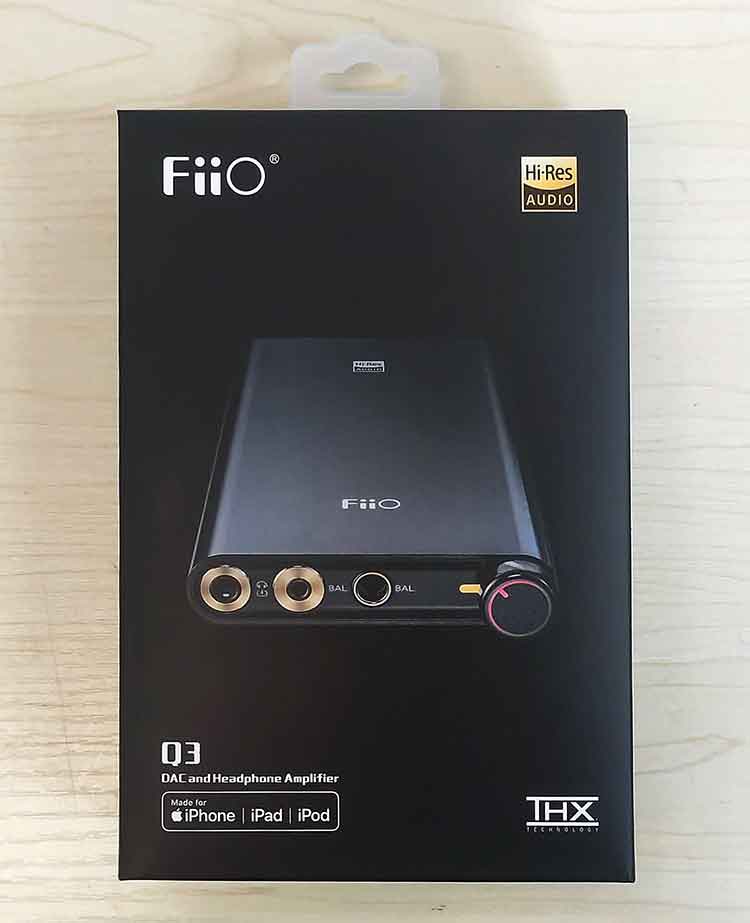The FiiO Q3 is a portable THX balanced DAC/amplifier using an AK4462 DAC with DSD512 native decoding and up to 300mW output power. It is priced at $149.99.
Disclaimer: The FiiO Q3 sent to us is a sample in exchange for our honest opinion in this review. We thank FiiO for this opportunity.
To learn more about FiiO reviews on Headfonics you can click here.
Note, this review follows our new scoring guidelines for 2020 which you can read up on here.
The new FiiO Q3 carries the THX AAA Frontier series amplifier circuit, with an upgrade over the Q1 Mark II to the latest AKM AK4462 DAC that can natively decode up to DSD512, and has it’s I/O expanded. It has been more than 2 years when we last saw a Q series device from FiiO, at that time a 4.4mm connection and USB-C was not yet popular on affordable gears.
The Q3 has been revamped in many ways, and like its siblings both digital and 3.5mm line-in connectivity are supported. Coming in an incredibly sleek form factor just 6mm longer than the Q1 Mark II, slots in neatly with a lot of what FiiO stands for in 2020.
Design
Putting the Q3 along the M15, Q1 Mark II, and K3 you can observe some design similarities. The rounded anodized aluminum bodies and knob placement of latest generation FiiO products are based on the same design aesthetics.
The front panel of the Q3 adds a 4.4mm connection, with room also for 3.5mm and 2.5mm balanced terminations as well so it is compatible with most balanced aftermarket upgrade cables.
FiiO has smartly touched up the design with a red ring on the knob facia as well as a LED indicator that displays the sampling rates of any audio signal. With 48kHz it will show blue, beyond 48kHz it will display yellow and DSD will get you green. There is also a low battery indication with a red light flashing when it nearly runs out of power.
Flipping to the bottom on the back panel 2 screws can be found. There is a bass switch, a gain button with LED (green light on when switching to high gain). You can also switch between two digital filters by double-clicking the round switch. A USB-C charging port sits in the middle with a switch on the right that you could use to turn off charging such that it won’t drain your phone/ laptop.
As the form factor may suggest the Q3 weighs incredibly light at just 110g, very similar to the Q1 Mark II (101g). It looks much sleeker than in the photos to the point where you can slide it into a pocket easily after bundling with a phone.
Packaging & Accessories
The packaging style from FiiO is consistent and professional. A sturdy inner box with separate compartments fits the main unit and accessories, including a soft pad to put between your phone to prevent potential knocks and damage.
There are also two sets of elastic bands for you to tie the Q3 to different gears. Inside the smaller box, you will find a Lightning to USB-C, USB-C to USB-C cable, and a 3.5-3.5 cable for analog line-in connections.
Features
The Q3 feels like a big update after the Q1 Mark II. Key components are brushed up while some opamps, ( for example, OPA1662), in the amplification path are kept. The peak output voltage on the Q3 is even higher than the more expensive Q5 so we are expecting some good power.
The Q3 uses an AKM AK4462 with Velvet Sound architecture which allows the Q3 to decode up to 32BIT/768kHz or DSD512 native, with enhanced THD performance and higher SNR (signal to noise ratio) than the Q1 Mark II.
Last but not least, the XMOS XUF208 USB controller is used. This is a mature solution that has been seen on other FiiO designs and offers a high SNR ratio and up to date decoding performance.
From official information the Q3 is Apple certified, USB-IF USB C compatibility certified, Hi-Res Audio certified, and comes with an official Thesycon USB Audio driver.
THX
The Q3 encases a fully-balanced THX structure amplification module under the AAA Frontier series. Officially, it claims to be the “World’s Most Linear Amplifier Technology for Headphones and In-Vehicle Audio Systems”.
The dual AAA 28 chipset design promise low levels of noise, distortion, and power consumption. It is also able to output great power under low voltage power supplies. So far, I am very positive with all amps using THX AAA technology inside such as the M11 PRO. They always seem to deliver good power and good control in the output.
You could read more about AAA technology here.
ADC Volume control
FiiO has continued with its ADC digital volume control design on the Q3 which eliminates channel imbalance issues at low volume with sensitive IEMs.
This is one useful feature especially for very sensitive IEMs that allows much more precise low-volume control using a traditional round knob, but not a digital volume that may press down the dynamic range.
With such implementation, there won’t be imbalance issues letting you enjoy sensitive IEMs i.e. Shure SE846 in a quiet room without the volume leaning to one side.
Channel balance issues have always been a nightmare for quiet listening especially with very sensitive multi-BA IEMs. Sometimes the volume can get too loud before you find the sweet spot so this is very helpful for sensitive ears.
There is no pop sound when you turn the Q3 on with the knob. The resistance is just right making it easy to fine-tune the volume levels. I personally prefer digital volume control but a nice implementation on the retro knob gives it more of an analog feel and it is much easier to control in a pocket.
EMF Shield
As the Q3 is designed to be stacked behind phones, we tested if phone signals would introduce a level of electric interference on the Q3’s signal. Buzzing high frequencies from EMF interference still affects many latest products so it is something I wanted to ensure the Q3 avoided.
Testing with my iPhone and my Android phones there is no sign of noise when a call comes in. According to FiiO, the body of the Q3 is machined from Aluminum and it has an alloy shielding cover over the key components to block external interferences.
The design works well to prevent unwanted noises and I am not experiencing any issues with both single-end and balanced output.
Digital filtering
The Q3 allows users to switch between two digital filters: one with a faster roll-off offering more rounded sound and the other one more opened up and extended in the treble.
Double-clicking the bass boost knob you will be able to switch between the sharper roll-off filter and a slow roll-off filter. Having only 2 filters may sound limiting but I find the sharper roll-off filter practical to tame sensitive and sharper sounding IEMs.
If you prefer more rounded highs if matched with warmer IEMs the slow roll-off filter will be better as the other filter limits the openness in the treble.
A few more filtering options would be nice but it could be confusing if there is no way to display which one is in effect, so the two filters given seem the right balance.
Battery Life
This is quite a big battery relative to Q3’s size allows up to 10 hours of playback. Testing on 3.5mm output lasts around 8-9 hours with a mix of files whereas with the balanced output you should expect the playback time to drop quite a bit.
If you are using balanced IEMs and the Q3 as an adapter, under emergency low power situations you can also get some juice from the hosting device, so it is even more flexible. Nevertheless, the battery time is sufficient for 2-3 days usage during commuting trips.
Line in Mode/Digital Decoding Mode
The Q3 prioritizes digital connections and when there is no signal from the USB input, it can automatically switch to a 3.5mm line-in to amplify incoming analog signals.
Under this mode only the balanced outputs can be used as the 3.5mm jack is taken to host the input signal. Whenever there are digital signals being inputted the Q3 will automatically switch back and stop the line-in 3.5mm signal.
Sound Impressions
Summary
The THX AAA equipped M11 Pro player proved itself in the market with its excellent linearity and overall sound performance compared to the original M11. An amplifying circuit under the same series from THX is also inside the Q3 and shares some of those sound traits. With most IEMs, the Q3 sound wider in staging with enhanced clarity compared to entry-level DAPs/phone output.
The tuning is quite natural sounding out of the box without a strong signature. IEMs that that are full-bodied and are able to extract more details in the lows have better synergy, especially on 4.4mm termination. The Q3 is not picky, indeed, quite forgiving with genres and different types of IEMs adding more space between instruments and the listener.
The 3.5mm output sounds softer and more compressed than the 2.5mm/4.4mm balanced outputs, which utilizes both THX AAA amplifier modules and outputs higher power. On 3.5mm output the sound is cutting off faster in both lows and highs, and the roll-off makes it boxier, less natural than the balanced output.
This could however tame some sharper sounding IEMs while they sound even more piercing with a higher power in the output. The 2.5mm/4.4mm outputs, on the other hand, offer cleaner bass punch, separation, and resolution. Overall, there is better quality with a superior treble extension. In any case, the 2.5mm/4.4mm connections are recommended as they are optimized.
Pre-Amping
You could use the Q3 as a preamp/volume booster for analog 3.5mm inputs and it has ample power to add dynamics and bass energy to small portable cans like the ATH M50. It struggles to power demanding cans but considering its size it is pumping out satisfactory power with decent performance with more sensitive IEMs.
The output is quite authentic compared to the original source, perhaps a tad bit warmer. Little noise is picked up and it is a safe tuning that does not magnify any frequencies for clarity.
Synergy
Output power
The driving power from the Q3 is significantly higher than mobile phones and doubles what Q1 Mark II offers peaking at ≥160 mW on a 32Ω load which is comparable to some entry to mid-tier DAPs.
While the balanced options offer slightly more power than the single-end output, the gain knob offers an extra boost to dynamics, adding more loudness and power to the output. This works best with dynamic IEMs or small cans or when you want the output to be cleaner.
Bass boost
The bass boost toggle option is nicely implemented with little bleed into the vocal range after switching on, elevating the bass/ lower vocal range upon its activation. It also works well with streaming and YouTube trending content especially in a noisy cafe or outdoor scenarios.
With some harder to drive IEMs or cans, the energy in the bass can be lacking. The bass boost option could give it a small push and add some welcome body to notes. This is a handy option but if you prefer more quality, you could try to add a few dB in bass via any source EQ.
Pairings
FiiO FA7
Using the FA7 via the Q3’s 2.5mm balanced cable there is sufficient power to enables a fast and deep bass performance while still delivering a smooth and rounded vocal. The soundstage is noticeably more expanded and the vocal positioning steps back a bit as a result.
The FA7 sounds smooth and less lean on the bass compared to the iPhone or any Android smartphone output. Resolution is enhanced as a result of the cleaner bass, and boosting to a higher gain helps open up the treble clarity a bit more.
With the Q3, the FA7 sounds less contained than on phones/entry-level DAPs, opening up the staging and pushing all instruments further out. It also enhances dynamics and control at the same time which makes it a better match with classical music.
Shanling ME700
The ME700 is a unique IEM that was released not too long ago. It delivers a retro, smooth, and full-bodied sound signature.
This 5 driver IEM consists of a 10mm gold-plated dynamic driver has dense mid-lows and super rounded treble, which works silky smooth with older tunes especially male vocals. It does require a good amount of power to clean up the thicker mid-bass and drive it to full potential.
Challenging the Q3 with the ME700, the combo sounds spacious, much less congested compared to phone outputs that could sound quite lossy and veiled. The Q3 helps render the mid-bass swifter and lighter without stealing too much attention while the vocal image blends softly into the background.
Percussion instruments and acoustic instruments have a more natural weight with the Q3. However, at the same time, the dynamics are improved when it is less focused on the mid-bass.
The gain switch helps to bring out more treble and the slow roll-off filter opens up space a bit better for vocals to breathe. The bass knob is too bassy for the ME700 listening indoors but may be useful to compensate for the noise outside when you are commuting, but it is harming resolution in this case.
This is not the best combo and does not expect the Q3 to be as resolving and powerful as higher-end gear which are made for handling IEMs like the ME700. It is sufficient to handle most low to mid-tier IEMs and best suits more sensitive ones.
Etymotic ER2SE
The ER2SE is a single dynamic IEM that sounds super clean and agile with its fast and light bass attack. It has good power to retrieve details in the higher registers and sounds extremely smooth in the vocal range. This is well complemented by the THX AAA amp module’s design which has little coloration and unaltered response while maintaining low distortion.
The Q3 allows for a weightier ER2SE vocal performance sounding less thin with male singers or darker voices. Genres including trance/club music that involves extensive use of digital bass elements now sound fuller. Switching on the bass knob strengthens the bass even more.
The 3.5mm output on the Q3 has richer lows than the balanced outputs and offers more warmth to the output. This is a smoother option than the balanced output but not as clean and detailed.
Overall, the Q3 adds a small hint of warmth to the ER2SE’s output, kicks deeper, and sounds more spacious. It makes it more enjoyable outdoors with the vocal being more pronounced and weighted. The vocal is also slightly more laid-back, more relaxing, and smoother when it comes to instrumentals or cleaner voices.
Selected Comparisons
Lotoo Paw S1
The S1 is an innovative device-powered dongle with lots of digital filtering options that you could use to add flavors to your gears. It is small and powerful while maintaining a spacious stage.
Putting it with the Q3 you will notice the Q3 being shyer in reshaping the output for excitement, instead, it is flatter, more controlled, and loyal to the source. With more power, the Q3 is creating a more vivid and 3D image while keeping more details in the mix. You could notice more details and energy in the bass as well as smoother articulation on the Q3.
I like how the S1 adds some extra crispiness and air with its filter also being very flexible to switch between different presets, to me it works great as an adaptor for higher-end earphones.
In contrast, Q3’s sheer performance in power in the bass guarantees stable performance in most cases and will be more friendly with entry or mid-level IEMs that need a boost in power while adding a more complete staging with better dynamics.
FiiO BTR5
The BTR5 is at a similar price to the Q3 and it offers high-resolution wireless audio decoding, excellent power in terms of a small Bluetooth receiver, it has clean bass punches and sounds quite balanced across the frequencies with its balanced output.
On Balanced output the Q3 has richer mid-bass with overall more details captured compared to the BTR5, it seems like wired transmission still gives the Q3 some advantage allowing it to deliver more energy in the bass.
The BTR5, however, sounds cleaner and faster listening indoor, more refreshing, and exciting in general and the Q3 being fuller, more rounded with its focus mainly in the mid-lows/ mids range.
I prefer using hybrids with the BTR5 for more natural bass response and more treble texture at the same time, sensitive IEMs with more bass in the tuning also form good pairings. As for the Q3, it has better synergy with IEMs that outputs stronger texture.
IEMs with more pronounced vocal in the tuning such as the iKKO OH1 are working well with the Q3 too and sound more natural. In general, the Q3 has fuller bass and is able to handle heavier loads and sound more spacious, while the BTR5 is more refined but more limiting in power.
FiiO K3
The K3 and Q3 look quite similar and both offer a USB-C connection, denoted by “3” as well. However, when you put them together the new Q3 beats the K3 in no second in terms of sound quality, detail retrieval, and power.
The level of details and separation are two steps up with the Q3 with the same USB output, where the Q3 has better treble extension/ control, a more distinct vocal image, and also better articulation that makes it sound more natural.
Unless you need a device-powered DAC and Amp I can’t think of any reasons not to pick the Q3, which is as portable, more flexible in connections, and offering better amplifying and decoding qualities. The K3 could, however, be handy if you need its USB to coaxial output converting function or requires just a functional soundcard with basic functions.
Our Verdict
Fresh AKM AK4462 DAC chips, THX AAA 28 amplifiers implementation, a generous set of accessories plus extensive I/O support makes the Q3 a flexible and practical DAC and adaptor option, turning phones into a DAP instantly.
It has good synergy with various entry-level to mid-tier IEMs that need a small boost in power to shine and balances features and output quality nicely while not costing a fortune. The quick access to change the digital filters is also a nice touch-up option when you use some sensitive IEMs.
With an extensive set of features and sufficient power, also a perfect form factor to put with a phone, the Q3 is an all-rounder, a swiss-knife of its kind, and a safe bet if you want to find your iPhone and amp or planning an upgrade to a 4.4 TRRRS system.
FiiO Q3 Specifications
- Audio Input: USB Type C
Outputs
- 3.5mm Single-ended
- 2.5mm Balanced
- 4.4mm Balanced
- Channel Balance: ≤0.2dB
- Battery Capacity: 1800mAh
- Charging Time: ≤2 hours
- Native DSD Supported: 64/128/256/512
- Max sampling rate supported: 32-bit/768kHz
Chipset
- DAC: AKM4462
- Amp: THX_AAA28
- LPF: OPA1662
- XMOS: XUF
SNR
- 3.5mm: ≥114dB
- 2.5/4.4mm: ≥115dB
THD+N
- 3.5mm: <0.0012%
- 2.5/4.4mm: <0.0012%
Output Impedance
- 3.5mm: 1.2Ω
- 2.5/4.4mm: 3Ω
- Weight: 3.8oz (110g)
- Dimensions:: 4.1 x 2.3 x 0.49” (105 x 59 x 12.5mm)





